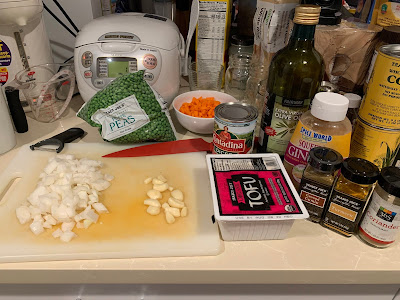My original plan for the Nepalese challenge was to make a paneer curry with some fried potatoes. That would have required a visit to a South Asian grocery store, which wasn't going to happen during the pandemic, so I decided to postpone the challenge. After looking at some more Nepalese recipes in the weeks that followed, however, I decided to just change plans and make something else with ingredients I had on hand or could easily obtain. The less challenges I needed to postpone, the greater chance I'd actually finish them when I was able to.
My new plan for the Nepalese challenge was to make vegetable tarkari, a traditional curry filled with vegetables and usually served with rice. The curry often contains potatoes, peas, carrots, and other vegetables, but in ours, I substituted tofu for potatoes. We were having some home issues at the time which meant we couldn't really leave food out on the counter, so potatoes were not an option, sadly. I don't know if tofu is typically used in this type of dish, but while googling, I did find a tofu tarkari at a Nepalese restaurant in San Francisco with tofu and green beans. To make the curry, I decided to use a recipe on Sareta's Kitchen as a starting point.
The ingredients for our version of tarkari were:
- 1 yellow onion ($0.60)
- 5-6 carrots ($0.59)
- 1-2 tbsp of chopped garlic ($0.20)
- 1 bag of frozen petite peas ($1.59)
- 1 block of firm tofu ($1.99)
- about 1 tbsp olive oil ($0.20)
- about 1 tbsp ginger paste ($0.20)
- about 1-2 tsp ground cumin ($0.10)
- about 2-3 tsp ground coriander ($0.10)
- about 1 tsp ground turmeric ($0.10)
- 1 can of diced tomatoes ($1.50)
- 1 cup of rice, uncooked ($1)
The total cost of dinner was about $8.17, and it made enough for the three of us for dinner, plus leftovers for another day of lunch. Very economical recipe!
The steps for our version of vegetable tarkari were:
1. Prep - dice onion, peel and chop carrots, chop garlic, thaw peas (mostly) under cold water, slice tofu.
2. In a large skillet over medium heat, add oil, and then cook the onions until softened. Add the garlic and ginger, and cook for a couple of minutes.
3. Add the carrots, and cook for a couple of minutes before adding the spices and stirring well to make sure everything is well-coated.
4. Add the tofu, and then after a couple of minutes, the peas and diced tomatoes (with juice). Stir well so everything is mixed together.
5. Cover and cook on low heat until vegetables are fully cooked, about 20 minutes. Add additional seasonings if needed. [I added more cumin and coriander.]
The vegetable tarkari was simple to make, but it just felt like it was missing something. I added more spices than the recipe called for to start with, and then added even more, but it still felt like it was on the blander side. It wasn't bad, as it mostly tasted like the vegetables it contained (which is a good thing), but I just thought it would have more flavor from the spices, especially since I tried it prior to adding the peas and tomatoes and the spices were very present. The spices didn't get much stronger the next day either when reheating the leftovers. B really liked it though, so I consider that a win.




























